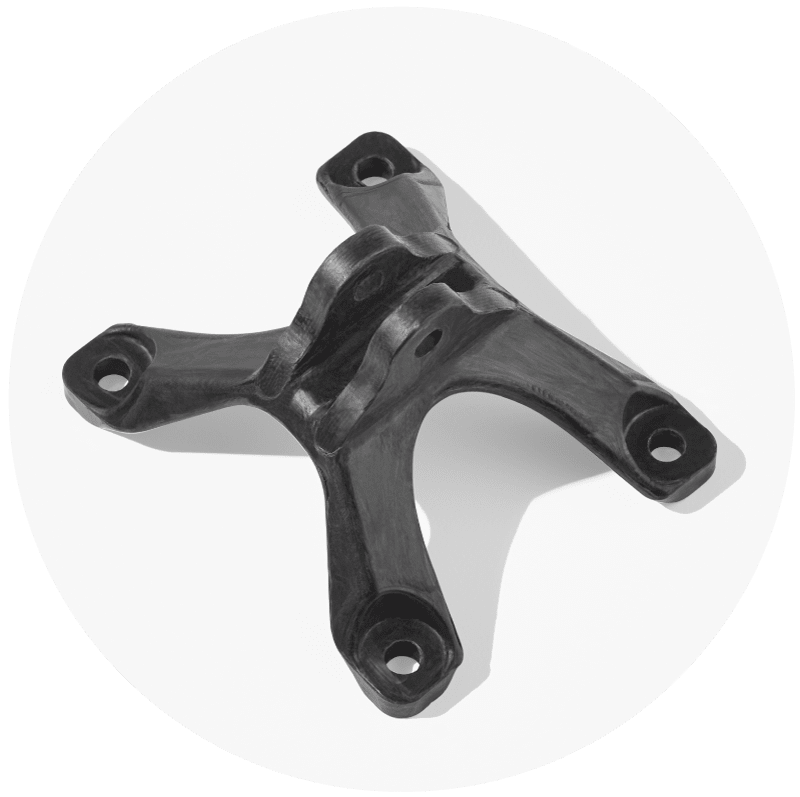The Next Era of Lightweight Structures Made To Outperform
From 76 grams to 16 grams, the redesigned bracket made with Additive Molding achieved the same stiffness as the titanium version at 21% of the weight.
This white paper explores the convergence of composites and topology optimization, ushering in the next era of lightweight structures for transportation and industrial applications.
- Baseline 3D printed titanium t-bracket vs. optimized 3D printed titanium 6-prong bracket vs. continuous carbon fiber composite 4-prong bracket made with Additive Molding by ARRIS
- The ARRIS bracket resulted in the same stiffness as the titanium bracket but at 21% of the weight
- Additive Molding is a first-of-its-kind technology that enables the mass-production of composites with greater sustainability (significantly lower waste than traditional composites and recyclable materials options, including high-performing natural fibers)

The ARRIS team would like to acknowledge Hunter Lee, Structural Engineer, and Dr. Ed Silverman, NG Fellow of the Northrop Grumman Space Systems Division, for their contribution in testing and comparing the results of the 4-prong additive molded composite brackets to their previous assessment of the baseline titanium 6-prong bracket… Read Whitepaper /// Download 7-Page PDF
ABSTRACT
Although advanced composite material outperforms metal on material data sheets, actual composite structures often fail to provide a significant improvement. This is partly due to the application of design approaches originally meant for metallic constructions. As a result, advanced composite structures have a redundant layup with a quasi-isotropic stacking sequence that eliminates anisotropy instead of leveraging it, the so-called black aluminum.
In today’s approach to taking better advantage of continuous carbon fiber’s mechanical properties, fibers are aligned based on the anticipated loading conditions. This can be achieved using hand layup or automated tape layup (ATL) / automated fiber placement (AFP) techniques. Though this provides a significant improvement over the “black aluminum” approach, it still falls short of realizing the full potential of continuous fiber anisotropy. Since carbon fibers perform best in tension, the part itself should be redesigned to take advantage of this effect. Though this exercise may seem intuitive for simple parts, these coupled design activities in the aerospace industry easily become non-intuitive due to the complex loading conditions for aircraft structures.
ARRIS Composites has developed a new process, Additive Molding, capable of manufacturing complex geometries using continuous fiber. This paper presents optimizing topology and fiber orientation for an aerospace bracket having complex 3D load cases. These optimized structures are shown to outperform current composite structures as well as structures machined and 3D printed from metal, making them ideal for next-generation aerospace brackets and joining structures.
Popular Posts
- Forbes Interview by Jim Vinoski: New cutting-edge running shoe at the Boston Marathon with first-of-its-kind carbon plate for next-gen footwear… [ READ ]
- ARRIS Unveils Structural Flax Fiber Composites: Natural fibers have the potential to bring sustainability benefits to the composites industry through their adoption as high-performance materials… [ READ ]
- ARRIS Signs CM, Increasing Additive Molding Production Capacity To 1M+ Parts: Scaling production capacity further by signing a contract manufacturing partner in March 2023… [ READ ]
Want to schedule a call or meeting to discuss Additive Molding with an Applications Engineer? Start a conversation today using our contact us page!
White Paper: Benchmark Study of RF Performance in Advanced Composites Design… READ
